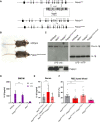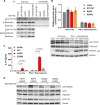Interrupting an IFN-γ-dependent feedback loop in the syndrome of pyogenic arthritis with pyoderma gangrenosum and acne
- PMID: 38408849
- PMCID: PMC11103328
- DOI: 10.1136/ard-2023-225085
Interrupting an IFN-γ-dependent feedback loop in the syndrome of pyogenic arthritis with pyoderma gangrenosum and acne
Abstract
Objectives: To study the molecular pathogenesis of PAPA (pyogenic arthritis, pyoderma gangrenosum and acne) syndrome, a debilitating hereditary autoinflammatory disease caused by dominant mutation in PSTPIP1.
Methods: Gene knock-out and knock-in mice were generated to develop an animal model. THP1 and retrovirally transduced U937 human myeloid leukaemia cell lines, peripheral blood mononuclear cells, small interfering RNA (siRNA) knock-down, site-directed mutagenesis, cytokine immunoassays, coimmunoprecipitation and immunoblotting were used to study inflammasome activation. Cytokine levels in the skin were evaluated by immunohistochemistry. Responsiveness to Janus kinase (JAK) inhibitors was evaluated ex vivo with peripheral blood mononuclear cells and in vivo in five treatment-refractory PAPA patients.
Results: The knock-in mouse model of PAPA did not recapitulate the human disease. In a human myeloid cell line model, PAPA-associated PSTPIP1 mutations activated the pyrin inflammasome, but not the NLRP3, NLRC4 or AIM2 inflammasomes. Pyrin inflammasome activation was independent of the canonical pathway of pyrin serine dephosphorylation and was blocked by the p.W232A PSTPIP1 mutation, which disrupts pyrin-PSTPIP1 interaction. IFN-γ priming of monocytes from PAPA patients led to IL-18 release in a pyrin-dependent manner. IFN-γ was abundant in the inflamed dermis of PAPA patients, but not patients with idiopathic pyoderma gangrenosum. Ex vivo JAK inhibitor treatment attenuated IFN-γ-mediated pyrin induction and IL-18 release. In 5/5 PAPA patients, the addition of JAK inhibitor therapy to IL-1 inhibition was associated with clinical improvement.
Conclusion: PAPA-associated PSTPIP1 mutations trigger a pyrin-IL-18-IFN-γ positive feedback loop that drives PAPA disease activity and is a target for JAK inhibition.
Keywords: Arthritis; Cytokines; Familial Mediterranean Fever; Inflammation.
© Author(s) (or their employer(s)) 2024. Re-use permitted under CC BY-NC. No commercial re-use. See rights and permissions. Published by BMJ.
Conflict of interest statement
Competing interests: SC has received consulting fees from Apollo Therapeutics and honorary speaker fees from Sobi and PracticePoint CME.
Figures







Similar articles
-
Inflammation in mice ectopically expressing human Pyogenic Arthritis, Pyoderma Gangrenosum, and Acne (PAPA) Syndrome-associated PSTPIP1 A230T mutant proteins.J Biol Chem. 2013 Feb 15;288(7):4594-601. doi: 10.1074/jbc.M112.443077. Epub 2013 Jan 4. J Biol Chem. 2013. PMID: 23293022 Free PMC article.
-
Excess Serum Interleukin-18 Distinguishes Patients With Pathogenic Mutations in PSTPIP1.Arthritis Rheumatol. 2022 Feb;74(2):353-357. doi: 10.1002/art.41976. Epub 2022 Jan 3. Arthritis Rheumatol. 2022. PMID: 34492165 Free PMC article.
-
Brief report: genotype, phenotype, and clinical course in five patients with PAPA syndrome (pyogenic sterile arthritis, pyoderma gangrenosum, and acne).Arthritis Rheum. 2012 Jun;64(6):2022-7. doi: 10.1002/art.34332. Epub 2011 Dec 12. Arthritis Rheum. 2012. PMID: 22161697 Free PMC article.
-
Alarming consequences - autoinflammatory disease spectrum due to mutations in proline-serine-threonine phosphatase-interacting protein 1.Curr Opin Rheumatol. 2016 Sep;28(5):550-9. doi: 10.1097/BOR.0000000000000314. Curr Opin Rheumatol. 2016. PMID: 27464597 Review.
-
Case Report: Pyogenic Arthritis, Pyoderma Gangrenosum, and Acne: A Single-Center Experience and Literature Review.Front Immunol. 2021 Oct 22;12:735851. doi: 10.3389/fimmu.2021.735851. eCollection 2021. Front Immunol. 2021. PMID: 34745107 Free PMC article.
Cited by
-
NLRP3-inflammasome Related Genes as Emerging Biomarkers and Therapeutic Targets in Psoriasis.Inflammation. 2025 Mar 3. doi: 10.1007/s10753-025-02271-y. Online ahead of print. Inflammation. 2025. PMID: 40029502
-
IFN-γ licenses normal and pathogenic ALPK1/TIFA pathway in human monocytes.iScience. 2024 Dec 10;28(1):111563. doi: 10.1016/j.isci.2024.111563. eCollection 2025 Jan 17. iScience. 2024. PMID: 39868044 Free PMC article.
-
In-vitro anti-acne activity of Teucrium oliverianum methanolic extract against Cutibacterium acnes.Front Pharmacol. 2024 Oct 3;15:1388625. doi: 10.3389/fphar.2024.1388625. eCollection 2024. Front Pharmacol. 2024. PMID: 39421673 Free PMC article.
-
Allogeneic hematopoietic cell transplantation for autoinflammatory disorders.Int J Hematol. 2025 Aug;122(2):190-198. doi: 10.1007/s12185-025-04021-0. Epub 2025 Jun 11. Int J Hematol. 2025. PMID: 40498270 Free PMC article. Review.
-
Targeting pyroptosis in myocardial inflammation and fibrosis: molecular mechanisms and therapeutic strategies.Apoptosis. 2025 Jul 23. doi: 10.1007/s10495-025-02151-8. Online ahead of print. Apoptosis. 2025. PMID: 40702245 Review.
References
-
- Jacobs JC, Goetzl EJ. “"Streaking Leukocyte factor" arthritis, and Pyoderma Gangrenosum”. Pediatrics 1975;56:570–8. - PubMed
MeSH terms
Substances
Supplementary concepts
Grants and funding
LinkOut - more resources
Full Text Sources
Medical
Miscellaneous

